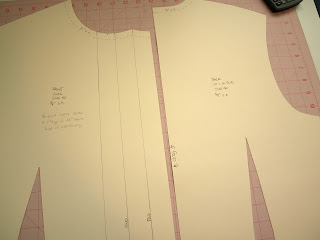So pleased I stumbled on you blog - wonderful work by the way! I am keen to start designing kiddies clothing and I am trying to find block patterns and relevant information on using/adapting them, that is not too confusing.The first thing to do is to define the term block pattern. A block pattern is a finished pattern with all seam allowances, notches, notation, etc. The pattern has been tested and approved for fit. It has been used, perhaps, in a style that has proven to be acceptable with customers.
I have got some info on-line and books out of the library but have not
found anything that I am happy with. I am wondering if you could give me any pointers on where to start looking and/or even purchasing basic block templates.
Developing a basic block pattern
A basic block pattern is a pattern from which all other styles are based. Sometimes they are derived from the original drafts created from body measurements with instructions from a pattern making manual. Sometimes not. A basic block pattern can also be the patterns from an approved style as described above.
Just as an example, we can look at my recent blouse making venture. After a bit of testing, the pattern pieces for that blouse have become my basic block patterns for future blouse styles. I cut them out of tag board so I can trace them off, either on fabric for cutting or on paper for drafting a new style. The pieces have seam allowances and notes to help for future construction.
Pattern makers in the industry do not draft from zero every season. We trace off existing pattern pieces (blocks) and modify them. Over time we create a library of pattern pieces that can be mixed and match for a variety of styles.
How to acquire basic block patterns
There is no easy way to acquire basic block patterns. These types of patterns are considered proprietary to the business that developed them so they are rarely for sell. That leaves new designers with a few options and none of them are easy. And perhaps, that is how it should be. I know that sounds harsh, but your patterns will be better if you struggle through the development process yourself. You will come to understand how things should fit and be sewn and know how your patterns work.So what are the options?
1. Draft your own patterns from body measurements using a pattern making manual. This is the most time consuming option, but ultimately the only way to ensure the fit you want.
2. Hire a pattern maker to do it for you. Probably the most expensive option. You will need to be prepared with a basic style, body measurements, etc. Expect a bit of back and forth as you refine fit.
3. Adapting commercial sewing patterns*. You can buy a commercial sewing pattern for a similar style but it will require a bit of fixing - actually a lot. Commercial patterns are usually sloppy and are not production ready by any stretch. One exception are Burda patterns which do not have seam allowances, so they will be easier to fix and adapt. Burda has even released their patterns as "open source", which is actually a misnomer. In other words, Burda has released their patterns with the license to use the pattern as you wish. And lest you think that I am encouraging the violation of the copyrights of commercial patterns, please know that the copyright status of patterns are in a legal quandry. In other words, in the U.S. no one can stop you from using the patterns you purchase as you wish, even though many believe they can. The only way to avoid that mess and confusion is to draft your own patterns from scratch.
4. Buy block patterns from someone else. I've never seen any production ready patterns available for sale. That doesn't mean it will never happen. I've even considered selling mine, but I haven't done it yet.
BTW, my blouse patterns were adapted from some Burda patterns and it worked well for the most part. The collar pattern pieces required a lot of work and I still don't have them right, IMO.
*If you buy a commercial pattern to take to a professional pattern maker to fix, you will probably be turned down. Commercial patterns require a lot of work to fix and it is honestly easier to draft a pattern from scratch. Some may turn you down for ethical reasons. Others may turn you down because you may give the impression that you are not ready or prepared to be a professional. I probably would turn you down too. The only way I would use a commercial pattern from a client is as a reference to match fit and styling while using my own block patterns or drafting from scratch.


Interesting about copyright of patterns... It seems like you should have the legal ability to protect your design. Could you get a patent? I'm sure it would be excessively expensive, but in theory could you do it? Or do the differences in sizes make it really unfeasible?
ReplyDeleteJust read your other intellectual property posts and answered my own questions. It seems marketing is the more surmountable problem in selling something, rather than actually making the product, so it does seem rather a waste of time to try and protect your product from being copied.
ReplyDeleteThanks for your comments Esther - much appreciated and 'food for thought'. I will check out Burda patterns and will also keep an eye on your blog just incase you do decide to sell your blocks. I'm sure you would find a great demand for them, especially as we can see the wonderful quality of your work!
ReplyDeleteShari (smallactsofgreen.blogspot.com)